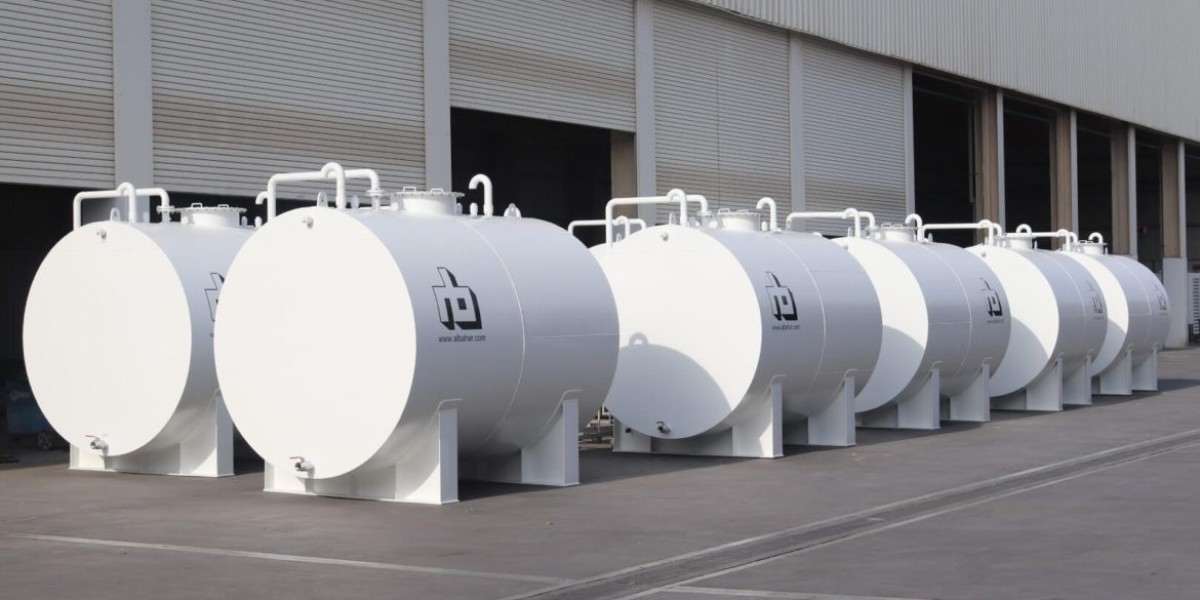When it comes to storing fuel safely and efficiently, above ground fuel tanks play an essential role across industries. From commercial fueling stations to industrial facilities, farms, and backup power systems, these tanks are designed to provide secure, accessible, and compliant fuel storage solutions. In this guide, we cover everything you need to know about fuel tanks above ground, including their design, applications, safety standards, and maintenance practices.
What Are Above Ground Fuel Tanks?
An above ground fuel tank (AST) is a storage container positioned above the surface of the ground, typically used to hold diesel, gasoline, kerosene, or other petroleum products. Unlike underground storage tanks (USTs), ASTs are visible and easier to install, inspect, and maintain.
They come in various sizes, shapes, and materials, depending on usage requirements. The most common designs include:
- Horizontal cylindrical tanks – widely used for bulk storage.
- Vertical cylindrical tanks – suitable for space-saving installations.
- Rectangular tanks – often customised for site-specific needs.
Key Benefits of Above Ground Fuel Tanks
1. Cost-Effective Installation
Installing an above ground fuel tank requires less excavation and site preparation compared to underground tanks. This makes ASTs more affordable for businesses looking for reliable storage without extensive groundwork.
2. Simplified Maintenance and Inspection
Since the tank is fully visible, operators can easily conduct routine inspections for leaks, corrosion, or structural damage. This accessibility reduces long-term maintenance costs.
3. Enhanced Safety
Modern ASTs are equipped with secondary containment systems, fire-resistant coatings, and overfill protection devices. These features significantly reduce the risk of fuel spills and environmental contamination.
4. Regulatory Compliance
Above ground fuel tanks are designed to comply with EPA, OSHA, and NFPA standards, ensuring safe and legal operations across industries.
5. Versatility
From backup generators to fleet fueling stations, ASTs can be used in multiple applications, offering flexibility to businesses of all sizes.
Applications of Above Ground Fuel Tanks
Commercial and Industrial Fuel Storage
Manufacturing plants, mining operations, and construction companies rely on ASTs for bulk storage of diesel and gasoline to power heavy machinery and vehicles.
Agricultural Use
Farmers use fuel tanks above ground for storing diesel and biodiesel, ensuring uninterrupted fueling of tractors, harvesters, and irrigation equipment.
Backup Power Systems
Hospitals, data centres, and government buildings install ASTs to provide reliable fuel for emergency generators during power outages.
Retail Fueling Stations
Gas stations use above ground tanks in locations where underground storage is not feasible due to soil conditions or space limitations.
Types of Above Ground Fuel Tanks
Single-Wall Fuel Tanks
- Designed with a single layer of steel or composite material.
- Require external secondary containment systems such as berms or spill containment basins.
Double-Wall Fuel Tanks
- Feature two walls with a sealed interstitial space that prevents leaks.
- Provide built-in containment, minimising the risk of spills.
- Preferred in environmentally sensitive areas.
UL-142 and UL-2085 Tanks
- UL-142 tanks: Industry standard for above ground fuel storage.
- UL-2085 tanks: Provide additional protection with fire-resistant insulation and impact resistance.
Regulatory Standards for Above Ground Fuel Tanks
Operating ASTs requires compliance with strict environmental and fire safety regulations. Some of the most important standards include:
- EPA Spill Prevention, Control, and Countermeasure (SPCC) Rule – requires spill prevention planning.
- NFPA 30 and NFPA 37 – codes for flammable and combustible liquids.
- OSHA regulations – ensure workplace safety in handling fuel.
- Local fire marshal codes – additional guidelines depending on location.
Compliance with these standards ensures safe storage while avoiding penalties and environmental hazards.
Safety Features of Modern Above Ground Fuel Tanks
To protect people, property, and the environment, modern ASTs are engineered with advanced safety features, including:
- Overfill alarms and shut-off valves
- Leak detection sensors
- Emergency vents and pressure relief systems
- Fire-resistant coatings
- Spill containment basins
These safety systems make ASTs a reliable and secure solution for fuel storage.
Choosing the Right Above Ground Fuel Tank
When selecting an AST, several factors must be considered:
- Capacity Requirements – Determine fuel demand to size the tank appropriately.
- Fuel Type – Choose materials compatible with gasoline, diesel, biodiesel, or kerosene.
- Regulatory Compliance – Ensure the tank meets UL, NFPA, and EPA standards.
- Location Constraints – Space availability and site conditions influence the choice of vertical or horizontal tanks.
- Safety Features – Double-wall designs and integrated containment improve safety.
Maintenance of Above Ground Fuel Tanks
Regular inspection and maintenance are crucial for extending the life of ASTs and ensuring compliance. Recommended practices include:
- Monthly inspections for leaks, corrosion, or damage.
- Annual integrity testing of tank walls and containment systems.
- Cleaning and fuel polishing to remove contaminants and water.
- Proper record-keeping for regulatory compliance.
Preventive maintenance not only enhances safety but also reduces operating costs in the long run.
Environmental Considerations
Environmental protection is a top priority when using above ground fuel tanks. Best practices include:
- Installing secondary containment systems to capture spills.
- Using double-wall tanks for sensitive areas.
- Implementing SPCC plans for spill prevention.
- Conducting groundwater and soil monitoring where necessary.
These measures help minimise the risk of fuel leaks and ensure sustainable operations.
Future of Above Ground Fuel Tanks
With advancements in technology, the future of ASTs is moving toward smarter, safer, and more efficient designs. Innovations include:
- Smart monitoring systems with real-time fuel level tracking.
- Automated leak detection and reporting.
- Corrosion-resistant composite materials for longer tank life.
- Integration with renewable fuels like biodiesel and ethanol blends.
As industries evolve, ASTs will continue to be a vital component of global energy infrastructure.
Conclusion
Fuel tanks above ground offer businesses and organisations a safe, cost-effective, and compliant solution for storing and dispensing fuel. With proper installation, maintenance, and adherence to safety regulations, ASTs can provide long-term reliability while protecting the environment.








